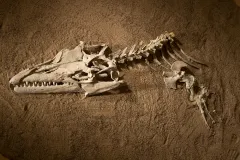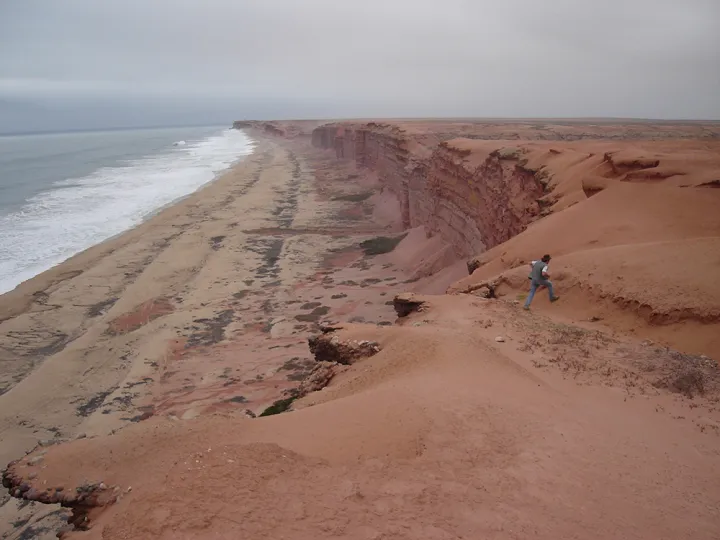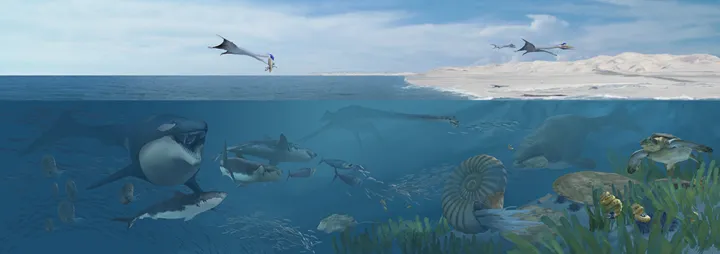If You Build An Ocean, Sea Monsters Will Come

Building a productive ocean is complicated. The process is long (on the order of more than 100 million years) and the conditions have to be just right. It starts with seafloor spreading—seven colossal plates of crust (along with some smaller ones) slowly move along with rock that makes up Earth’s mantle. These huge puzzle pieces collide and warp into new shapes, are recycled into the mantle, and even split into new pieces over millions of years in a process called plate tectonics. These shifting plates cause earthquakes and volcanic eruptions at their most active boundaries. The plate movements also form the geologic features of Earth: oceans, mountain ranges and islands form, and continents rift apart.
Scientists, such as paleontologists Louis Jacobs, Michael J. Polcyn and their team at Southern Methodist University, along with scientists in Angola, Portugal and the Netherlands, study the opening of the South Atlantic Ocean and its effect on ancient life. Projecto PaleoAngola examines this ancient ecosystem and the mechanisms that shaped it in order to understand how geology impacts ecosystems in both prehistoric and modern eras.
Projecto PaleoAngola research is focused on the Cretaceous precursor to the Benguela Current Large Marine Ecosystem. This highly productive marine environment is located off the coasts of Angola, Namibia and South Africa on the western boundary of south-western Africa. However, this ecosystem has not always existed. It took millions of years of tectonic plate movement and a complex geological history for this area of the South Atlantic Ocean to form. Once it did, a thriving ecosystem ruled by giant prehistoric marine reptiles took shape. Projecto PaleoAngola scientists have unearthed fossils of the ancient reptiles embedded in the desert sea cliffs of Angola—a location once covered by sea water, then by up to 6,000 feet of rock that was raised and eroded away to expose the fossils. Today the same geologic processes that created and preserved this ecosystem millions of years ago are still ongoing, only different animals swim through the water and in a slightly different place.
“Plate tectonics creates the ocean basin, first by rifting continents and then by seafloor spreading. Seafloor spreading is the mechanism of plate tectonics by which oceans grow,” Jacobs explains. Around 134 million years ago the South Atlantic Ocean began to form as the Gondwana continent pulled apart. The landmasses that would become South America and Africa stretched away from each other. About 15 million years later (roughly 120 million years ago), seafloor spreading began and the ocean basin between the two new continents took shape. A nascent marine ecosystem began to emerge. At first there were no large reptile predators because the ecological conditions were not suitable. By 88 million years ago the phenomenon of upwelling—when cold and nutrient-rich water moves from deep to surface waters—increased productivity along the Angolan coast and sizable marine reptiles moved in.
Southeast trade winds blowing along the new continent’s coastline pushed ocean water away from the shore, allowing this upwelling to occur. The nutrient-rich deep water fueled the growth of tiny photosynthetic organisms—phytoplankton—at the base of the marine food chain. The phytoplankton fed the zooplankton, fish ate the zooplankton, and as Jacobs put it, the “bigger fish ate smaller fish.”
Large opportunistic marine reptiles moved in through the northern and southern ends of the South Atlantic to feed on the now thriving ecosystem. As the South Atlantic formed in the Cretaceous geological period, these large carnivores included mosasaurs, plesiosaurs, and ancient marine turtles. Upwelling in the area also created a perfect habitat for very large oysters to flourish. Oysters provided an irresistible, all-you-can-eat buffet for Globidens, a mollusk-eating member of the mosasaurs. This huge marine lizard, like other mosasaurs, was related to present-day monitor lizards. It had a snout full of strong, rounded teeth ideal for crushing an oysters’ protective shell.
Mosasaurs moved like sharks in the water, but unlike sharks their skeletons were made primarily of bone instead of cartilage. When the mosasaurs ruled the South Atlantic Ocean 72 million years ago, the ecosystem off the African coast provided these immense reptiles with plentiful food. In addition to oysters, mosasaurs preyed on ammonites, fish, and marine turtles. The fossil remains unearthed by Projecto PaleoAngola scientists in modern day Angola revealed these sea monsters even preyed on smaller mosasaurs of their own species.
Life on planet Earth is heavily influenced by geological processes—ecosystems are reliant on them to exist. Without the plate tectonics movement that created the South Atlantic Ocean basin, or the upwelling that brought up necessary nutrients for primary production, the area off the coast of Angola might never have been so suitable for mosasaurs. These unique creatures of the past were able to thrive in the ocean off Angola for much the same reasons that today’s large marine mammals can survive there now. Present day fish eat the phytoplankton and zooplankton, and bigger fish eat them. Orcas and dolphins then eat those bigger fish. Life goes on for these modern marine animals much like it did for ancient mosasaurs.
Editor's note: The great mosasaur fossils along with other animals that lived in the ancient Angolan sea will be on display in the Sant Ocean Hall beginning November 9, 2018. Come by the new exhibit to learn more about how geology impacted the lives of these amazing creatures and their marine ecosystem!




